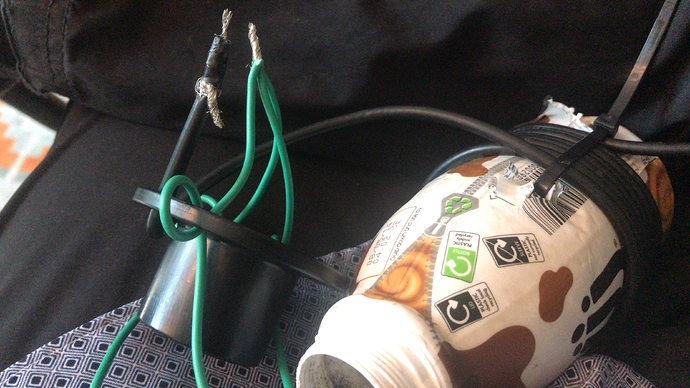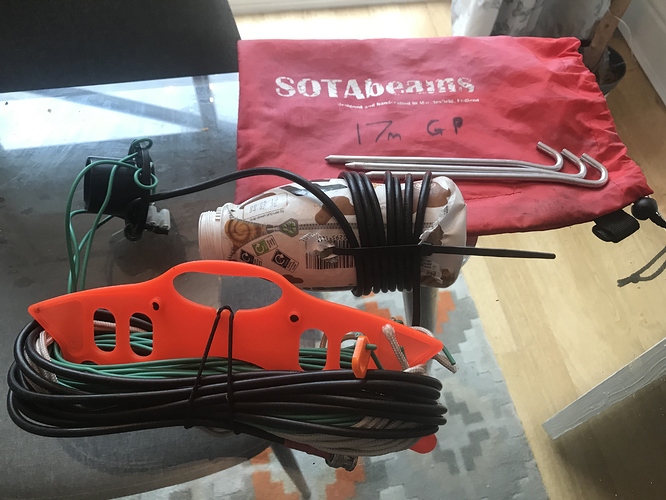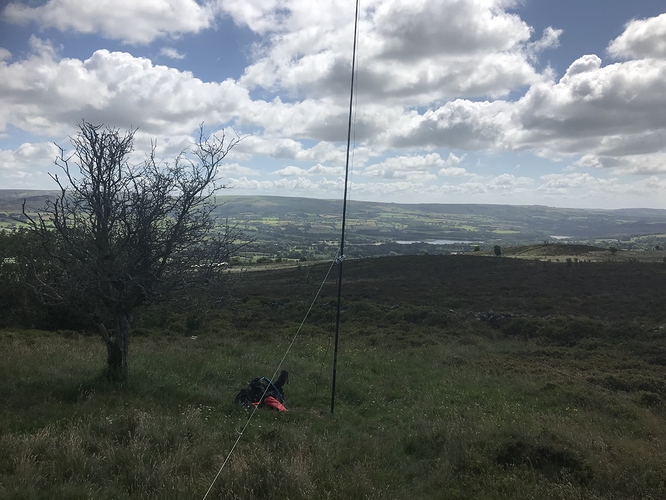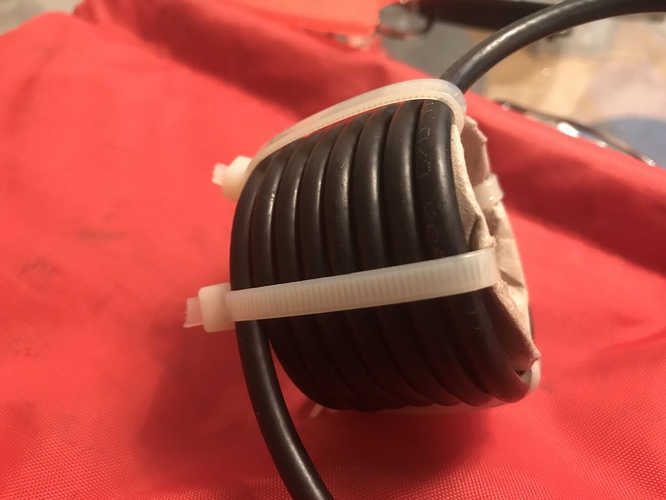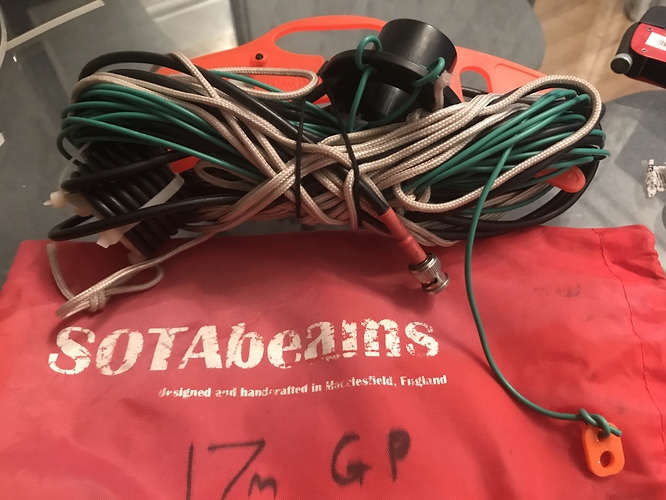To feed my new SOTA hobby, I’ve gotten an interest in building my own antennas. Starting simple, I made a speaker wire dipole, but that didn’t require any feed line. Next up, I’m in the process of a tape measure yagi, then possibly a linked dipole. All the plans I’ve read on the tape measure antenna use RG58 to a BNC. The Sotabeams linked dipole kit links to some RG174/BNC, but says you can use RG58 as well. Since I’ve never done anything like this, I’ll need to buy all the coax, ends, crimper, etc., and would like to standardize and buy one set of everything, if appropriate for these, and other potential future projects. Which do you recommend I go with?
RG58 is a lot easier to put connectors on and is lower loss than RG174. For my SOTA activations, though, I use a purchased 15’ length of RG174 complete with BNC connectors. It is much lighter in weight than RG58, (which in turn is lighter than RG8X, which is lighter than RG8).
When I started doing SOTA activations, I lived in NE Alabama with lots of trees to hang the antenna from. I started with a homemade G5RVjr antenna fed with a purchased RG58 coax assembly. As time went on and as I strived to lighten my pack, I went to a endfed antenna setup and changed to RG174 coax.
Currently, I use an End Fed Half Wave antenna with a 49:1 un-un transformer and configured in an inverted L, with the transformer at the base of the L. If you will be feeding the antenna from the top of the pole, then you will need a 25’ piece of coax. Out here in AZ, many of the summits need a fiberglass pole as there are no trees. The weight of RG58 coax would bend over the top of the pole, unless fed in an inverted L.
If you will be building different antennas for different purposes (not all SOTA), you might want to just buy complete coax assemblies of various standard lengths. You will miss the fun of making your own custom coax assemblies, but probably will save money in the long run.
73,
Dave, AE9Q
Probably the main drawback with RG-174 is that you have to be careful with it.
It’s pretty fragile compared to the RG-58. With short runs you don’t have to
worry about loss. I put up a 2 meter antenna on the roof of a 3 story apartment
building and ran RG-174 down to my first floor apartment and it worked fine. It
was a surprise to me! As Dave said, it’s a bit tricky to put coax connectors on
174…
73, John, K6YK
I will vote for RG-58 or RG-8X. There have similar diameter, but RG-8X has lower losses. They a not as fragile as RG-174, and allow using at 100 W. RG-174 is rated for QRP only.
Hi,
RG174 is lightweight and flexible and has acceptable losses on hf if the length is no more than around 25 ft. It will take 100 W OK if the SWR is under 2:1. It is popular amongst SOTA activators.
Do not use more than 3 ft above 100 MHz. You lose 8.5 dB per 100 ft at this frequency or about 1 dB for 10 ft on 2 m.
I use it on my SOTA HF antennas with powers between 0 5 and 75 W. I don’t consider it fragile but I don’t yank it or stand on it or use it under tension.
I also make sure the connectors have heat shrink tubing at the interface with the cable for stress reduction.
RG58 comes in various forms and is easy to work with. It is thicker and stiffer than RG174 and can be a bit heavy for a squid pole unless you tape it to the pole at the top and every foot down to halfway. It is OK to 300 W on HF. I would try to keep my line lengths below 30 ft on 2 m.
Most versions of RG8 are easy to work with. Most can be crinped satisfactorily.
RG58 is too heavy for SOTA IMO. RG213 is the current version BTW. RG58 variants can be good or rubbish. Easy to fit connectors.
Look on line for some guidance in connector assembly.
73
Ron
VK3AFW
You need coax long enough to feed your various antennas you use, this may be end fed, dipoles etc. This length helps decide whether you incur any real losses. I like to squeeze as much into the antenna as possible. But it does come at a price, you can’t go wrong with the best low loss cable and quality connectors you can afford. I use LMR240 Ultraflex + BNC + PL259 connectors the whole 10 meter length ids not heavy and coils quite naturally. 73 Mike
How about something inbetween? RG 316
More flexible and lighter than RG58.
Not unimportant for backpack compatibility.
Unfortunately a bit on the pricey side.
73 Joe
I’ve used RG174 for nearly 14 years of SOTA. I’m on the second length now as I retired the first length in 2012 when it developed a break somewhere. This current length could do with replacement simply based on its age and number of deployments. Highest frequency used is 18MHz. I have about 10m in use for dipoles as that gives enough length for a 5m pole and slack on the ground, often needed on Scottish summits so I can hide out of the wind but deploy the antennas.
You can get RG174 BNC connectors which are a clamp fit. With RG58 style BNC connectors you need to make extra strain relief, I use heat shrink and PVA hot glue to rigidly locate the thin cable in the socket. Not pulled one of or had a fail at the connector. Well, not yet.
I have an RG316 feeder too. It is expensive but I found a short roll at a radio fair and got about 17m for £5. I have that with connectors mounted the same. I’m not sure about the durability yet. RG316 does not like soldered connectors as it makes the wire brittle and is a failure point, they should only be crimped. I used standard RG58 solder connectors as that was what was available.
RG316 needs to be coiled correctly or it will develop permanent kinks and sets in the plastic.
RG174 uses a copper coated steel centre and is more lossy than DXWire’s DXW174. But I don’t see that listed on their website at present.
That’s not always true. The stuff used at SOTABEAMS is a stranded copper inner. We did try the steel stuff but it was horrible in nearly all respects.
You live and learn Richard. I’ve only ever seen the copper coated steel. I now know where to get some better 174 from as my current feeder has earned its retirement.
The answer to the question is RG58.
That’s for clumsy oafs like me who are not the most “practically adept”.
That said, I successfully built my 30m GP with RG174. My dipoles for 40, 60 and 80 have RG174 - but someone else made those. My GPs for 30, 20, 17, 15, 12, 10 and 6 all have RG58 feeder - I built all those.
My experience is the RG58 makes a slight enhancement to performance on the higher HF bands. Thicker core wire for the actual antenna is good too, because then you get a wider usable frequency band. Of course, these combine to make your antenna potentially twice the weight it might otherwise be - albeit still compact and lightweight in the grand scheme of things.
Yep. I just placed my first SOTABEAMS order in the post-CWI era last week - to get all the ingredients to build my new 17m antenna for the August flavour. What I particularly like about the products is that they (to use a topical phrase) “level up” access to antenna building, to those of us lacking the higher levels of practical skill.
The Frij milkshake carton is not a SB product btw. No doubt they’ve got something for making choke baluns too - I forgot to check.
Good use of “available materials” for the balun form Tom… you get a gold star from me and you had the benefit of drinking a tasty beverage. If only you had a discarded Big Kahuna Burger wrapper in the picture!
You can use a sharp craft knife to cut the ends off the bottle and save a bit of weight and volume. Get a responsible adult to supervise you when using sharp tools Tom as we don’t want you losing any digits. 
That’s some cable Tom, are you intending to jump start a Saturn V 1st stage ?
I just checked and Sotabeams price for RG174 is tasty and £5.50 for a BNC plug fitted makes it hardly worthwhile to switch the soldering iron on. I feel my credit card sweating!
There are a lot of good comments here. Ultimately for portable work—hard portable work—you realistically are probably looking at RG-174 For HF at least some of the time. I was down on it initially and questioned why SotaBeams used it on the band hopper, but Richard knows his stuff and I came around. It is much smaller, much lighter, and easy to use. There is definitely more loss and it is more fragile as noted by others. I have pulled a BNC connector off the end when rolling it up. But for strenuous hikes and QRP operation for no more than 14 MHz I will sacrifice a bit more loss at the practical lengths For the benefits. The weight and size of larger cable just are not worth it on many hikes and on a few it is not safe Adding imbalance or bulk when climbing.
If I am trying to get all the signal possible, go with a larger cable, maybe even RG-8x. Larger would be much more inconvenient. I personally would never use RG-174 for 2 meter or higher frequency no matter how short due to loss.
The truth is, you will probably end up with a variety of antennas and choose which to take based on the factors of your particular activation. My primary antenna for this last Field Day has a problem During the event. I had some backups but for convenience of putting up only one more antenna I raised the BandHopper in the tree for 20/40 and continued on with QRP.
We are. Neat coil with turns held in place. 
It’s a good choke, because the input and output ends are well separated from each other. If they are not, current on the outside of the coax (the stuff we want to suppress with the inductance of the coil) can leak across to the other end of the choke by capacitive coupling, making the choke useless.
that said, I don’t use a choke with my centre fed, centre supported dipoles, which are all fed with RG58 Coax. Which has never directly caused a collapse of the pole, to my knowledge. Tying it to the pole to reduce flapping in the wind is a good precaution.
The lack of a choke has not caused any problems in my scoring rate, which is as high as anyone else’s apart from the activators that spend 5 hours on the summit.
Dipoles in text books are drawn as a horizontal wire supported at the ends, with a feedline drooping down in the middle. The centre supported, coax fed dipole is electrically equivalent and actually works better than a dipole with a droop in the middle, as the centre support puts the part of the antenna with the highest current highest above ground. Also, only one support is actually needed. And the inverted Vee format makes it omnidirectional, within a db or so, making the orientation immaterial.
As a short length of feeder, RG316 and even RG178 are probably fine. However, my experience is that the outer jacket on these types of coax is very thin and fragile. It’s not a major factor for us in SOTA (my portable End-Connected Windom is still going strong), but it is not really suitable for long term outdoor installations.
I have had 2 End-Connected Windoms start to leak through the jacket and the copper braid has corroded. The antennas still work but it’s not ideal. I reinforce these types of coax with clear heatshrink if I am winding them on a ferrite. For a home station antenna, normal RG174 is probably better as the jacket is far more UV resistant. Thankfully, I still have plenty of DXW174 in the attic; I do hope they get some more in stock, it’s ideal for us SOTA activators.
73 de OE6FEG
Matt
Thanks for all the responses. As with most things, it appears there is no “one size fits all” here either. I will find an inexpensive piece of RG58 with BNCs on it on Amazon and cut it and solder it for my tape measure yagi. If/when I do more SOTA antennas, I’ll look to get some high quality RG174, ends and tools to build them.
Good fun tape-measure Yagis. They don’t work in the wind though, they collapse. Been there and discovered that. The question to ask is “will it ever be windy on top of a mountain?”
Be aware there is coax and there is cheap coax and there is cheap Chinese coax.
Not sure why you want to buy a cable with fitted connectors and then cut them off?
